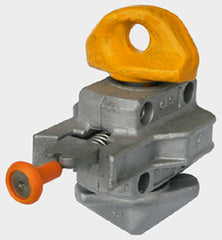Intermodal Transportation: Container Securing Rules
We thought it may be useful to publish the container securing rules published in the US by the Federal Government. Of course the container securing rules further down this post are really for the shipping industry and not necessarily of interest to people who are building container homes or mobile offices. Unless of course your design includes stacking containers. Especially if you are thinking of securing your stack with Container twistlocks or lashing rods and turnbuckles.


Photos: Container twist lock (left) Lashing rods (top right) Turnbuckle (bottom right)
Twist Locks: A twistlock in combination with standard corner castings on containers together form a standardized rotating connector for securing shipping containers or locking them together. The primary uses are for locking a container into place on container ship, semi-trailer truck or railway container train; also for lifting of the containers by container cranes and sidelifters.
Lashing rods: Lashing rods secure the base of the stack. Rods normally in two different lengths go from the bottom to the second or third row in the stack. The rule on ships used to be no more than 7 containers in a stack. The biggest ships today have stacks that are 12 containers high and each container can weigh 30,000 kg so imagine the weight on the bottom of the stack. Lashing rods often tensioned by turnbuckles stop the base of the stacks from moving. Any movement may cause the stack to collapse.
Turnbuckles: Turnbuckles of varying lengths tension the lashing rods on a container ship. They usually go between the lashing rods and D rings welded on the deck of the ship.
To see what happens on a ship when the stack collapses take a look at this post. Building with shipping containers - Make sure you get it right!
Securing Rules Title 49: Transportation Part 393: PARTS AND ACCESSORIES NECESSARY FOR SAFE OPERATION
Subpart I – Protection Against Shifting and Falling Cargo Specific Securement Requirements by Commodity Type Sec. 393.126 — What are the rules for securing intermodal containers? (a) Applicability. The rules in this section apply to the transportation of intermodal containers. Cargo contained within an intermodal container must be secured in accordance with the provisions of Sec. Sec. 393.100 through 393.114 or, if applicable, the commodity specific rules of this part. (b) Securement of intermodal containers transported on container chassis vehicle(s). (1) Each intermodal container must be secured to the container chassis with securement devices or integral locking devices that cannot unintentionally become unfastened while the vehicle is in transit. (2) The securement devices must restrain the container from moving more than 1.27 cm (1/2 in) forward, more than 1.27 cm (1/2 in) aft, more than 1.27 cm (1/2 in) to the right, more than 1.27 cm (1/2 in) to the left, or more than 2.54 cm (1 in) vertically. (3) The front and rear of the container must be secured independently. (c) Securement of loaded intermodal containers transported on vehicles other than container chassis vehicle(s). (1) All lower corners of the intermodal container must rest upon the vehicle, or the corners must be supported by a structure capable of bearing the weight of the container and that support structure must be independently secured to the motor vehicle. (2) Each container must be secured to the vehicle by: (i) Chains, wire ropes or integral devices which are fixed to all lower corners; or (ii) Crossed chains which are fixed to all upper corners; and, (3) The front and rear of the container must be secured independently. Each chain, wire rope, or integral locking device must be attached to the container in a manner that prevents it from being unintentionally unfastened while the vehicle is in transit. (d) Securement of empty intermodal containers transported on vehicles other than container chassis vehicle(s). Empty intermodal containers transported on vehicles other than container chassis vehicles do not have to have all lower corners of the intermodal container resting upon the vehicle, or have all lower corners supported by a structure capable of bearing the weight of the empty container, provided: (1) The empty intermodal container is balanced and positioned on the vehicle in a manner such that the container is stable before the addition of tiedowns or other securement equipment; and, (2) The amount of overhang for the empty container on the trailer does not exceed five feet on either the front or rear of the trailer; (3) The empty intermodal container must not interfere with the vehicle's maneuverability; and, (4) The empty intermodal container is secured to prevent lateral, longitudinal, or vertical shifting. [Federal Register: September 27, 2002 (Volume 67, Number 188)] [Rules and Regulations] [Page 61211-61235] From the Federal Register Online via GPO Access [wais.access.gpo.gov] [DOCID:fr27se02-37]
